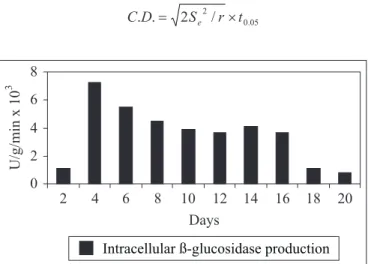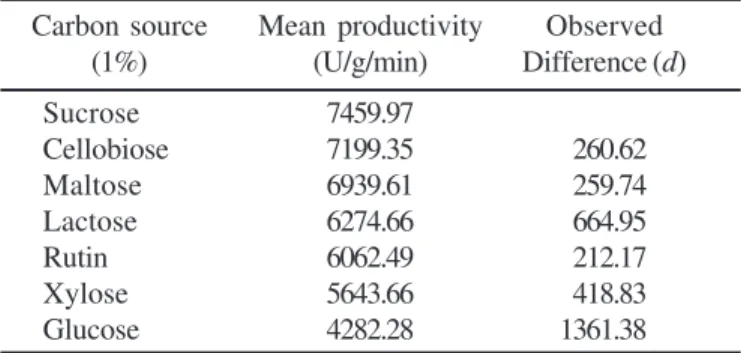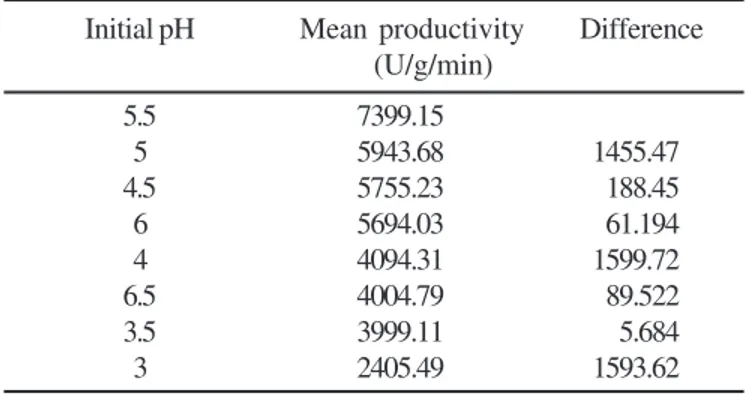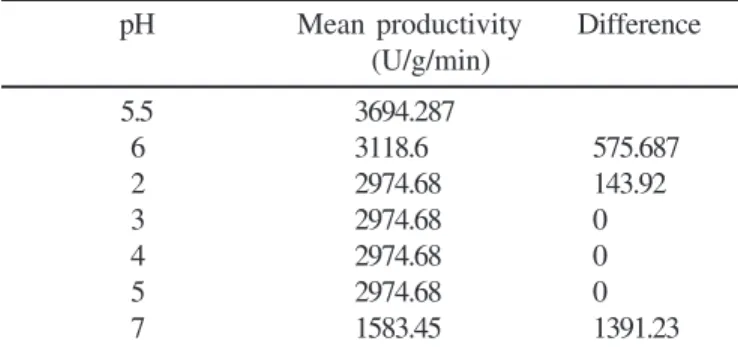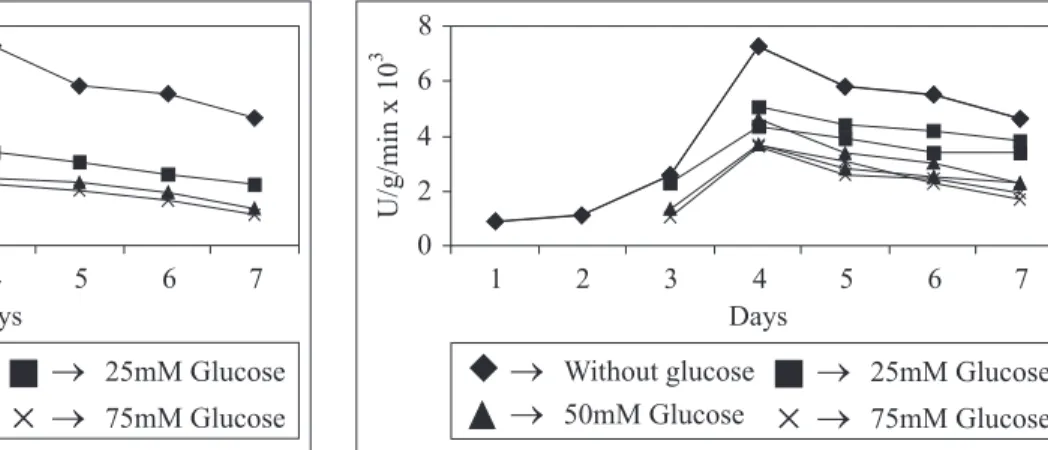PRODUCTION OF ß-GLUCOSIDASE BY PENICILLIUM PURPUROGENUM
A.B. Dhake; M.B.Patil*
Post Graduate Teaching Department of Biochemistry, L.I.T. Premises, Nagpur University, Nagpur, India
Submitted: January 31, 2004; Returned to authors for corrections: July 07, 2004; Approved: June 28, 2005
ABSTRACT
The fungus Penicillium purpurogenum was found to produce intracellular ß-glucosidase. Maximum activity
of ß-glucosidase was observed on sucrose. Various cultural parameters of cultivation of P. purpurogenum for
production of ß-glucosidase were optimized. Maximum enzyme content was observed after 96 hours of cultivation at 30°C. Addition of amino acids histidine and cysteine induced ß-glucosidase synthesis to certain extent. The optimum temperature and pH for glucosidase activity was 50°C and 5.5 respectively.
ß-glucosidase of P.purpurogenum shows stability at pH 2 thus it could be an ideal enzyme for debittering in
fruit juice and wine industries.
Key words: ß-glucosidase, Penicillium
INTRODUCTION
ß-glucosidase or ß-glucoside glucohydrolase [EC 3.2.1.21] has been widely used in ethanol production using various cellulosic agricultural residues such as corn stover, straw and bagasse (1,14,26) and in the synthesis of useful glucosides (5,21). In the flavor industry, ß-glucosidases are also the key enzymes in enzymatic release of aromatic compounds from glucosidic precursors present in fruits and fermentation products (6,11,23). ß-glucosidase is also useful in the process of deinking of printing ink from wastepaper (4,9,24).
Many bacteria, fungi and yeast have been shown to produce
the enzyme ß-glucosidase. The bacteria like Bretlanomyces
bruxellensis (11), Oenococcus oeni (11) and Clostridium thermocellum (7), the fungi like Aspergillus oryzae (16),
Fusarium oxysporum (2), Trichoderma reesei (19), and the
yeasts like Candida peltata (18), Candida curvata (20) are
also reported to be the main producers. Penicillium
purpurogenum is among the few fungi, which produced intracellular ß-glucosidase. The objective of the present investigation was to optimize the cultural parameters for
maximum production of ß-glucosidase by P. purpurogenum.
Effect of initial pH, agitation and different carbon sources on enzyme production has been studied. The effect of additives
*Corresponding Author. Mailing address: Post Graduate Teaching Department of Biochemistry, L.I.T. Premises, Nagpur University, Nagpur-440 033, India. E-mail: mbpatil1956@sify.com
like amino acids, detergents and vitamins are also determined. The catabolite repression by glucose on enzyme production has also been observed.
MATERIALS AND METHODS Organism, maintenance and culture condition
P. purpurogenum was isolated from the decaying wood in our laboratory and identified by IMT, MTCC, Chandigarh, India. The isolate was maintained on potato dextrose agar (PDA), pH 5.2 to 5.8, at 4°C, by periodic transfer. All the chemicals used were of analytical grade. The culture was transferred to new slants at every two months to keep it viable.
The medium used by Riou et al. (16) with composition of
[0.2%NaNO3, 0.2% KCl, 0.1% KH2PO4, 0.1% NH4NO3, 0.1%
NH4H2PO4, 0.05%MgSO4· 7H2O, 0.05% yeast extract; pH 6.0]
supplemented with anappropriate carbon source at a
concentration of 0.5% (W/V) was used. The medium used for production of ß-glucosidase by Saha and Bothast (18) had the following composition (per liter): 10 mL of solution A, 10 mL of solution B, 100 mL of solution C, 10 g of yeast extract, and 10 g of glucose. Solution A was a trace mineral solution having the following ingredients (per liter): 1.1 g of CaO, 0.4 g of ZnO,
CoCl2.6H2O, 0.06 g of H3BO3, and 13 mL of concentrated HCl.
Solution B (per liter) was composed of 10.1g of MgO and 45 mL of concentrated HCl. Solution C (per liter) contained 64 g of urea, 12 g of KH2PO4, and 1.8 g of Na2HPO4. Substrates were
sterilized separately. Czapek-Dox medium [0.6% NaCl, 1% Sucrose, 0.05% MgSO4· 7H2O, 0.15% KH2PO4, 2.5% NaNO3, pH
5.5] used by Patil and Shastri (13) was found to be best for ß-glucosidase production. The flasks with 1/5 liquid medium of its volume were inoculated with loopful spores from slants of
P. purpurogenum and incubated at 30ºC for 4 to 5 days under static condition.
Extraction of intracellular enzyme
After desired period of incubation the mycelial mass was collected by filtration, washed with distilled water, and crushed in cold distilled water. The mycelial extract was centrifuged at 5,000g for 20 min at 4ºC. The supernatant was used as the source of enzyme.
Enzyme assay
ß- glucosidase assay was based on the procedure described by Riou et al. (16) by mixing 0.1 mL of 5 mM P-nitro phenyl ß-D-glucopyranoside (pNPG) and 0.4 mL 0.1 M Sodium acetate buffer at pH 5.5. After incubation for 10 min at 50ºC, the reaction was stopped by addition of 2 mL of 1 M sodium carbonate and the liberated P-nitro phenol was monitored at 420 nm. One unit of ß-glucosidase activity corresponded to the release of 1 µmol of p-nitro phenol min-¹ under the assay conditions. ß-glucosidase activity was reported to be units/g/min of the mycelium.
Effect of environmental variables on ß-glucosidase production
The effect of various carbon sources was studied by replacing sucrose in the production medium with different carbon sources. Similarly, the sodium nitrate was replaced with various nitrogen sources. The starting pH of the medium was varied between 3 and 6.5. The effect of different concentrations of NaCl was also studied. The effects of various additives were also studied on 0.5% concentration level on ß-glucosidase production. The effect of different glucose in 25mM to 75mM concentration by supplementing glucose at regular interval of 24 hours up to 72 hours starting from the time of inoculation was also studied on enzyme production.
Characterization of ß-glucosidase
ß-glucosidase activity was measured at different temperatures
(30 to 70oC). The enzyme activity was measured from pH 2 to 7
by using the buffers of various pH in the standard protocol as mentioned above. The buffers used were HCL-KCL (0.1M, pH 2), Sodium citrate (0.1M, pH 3), Sodium acetate (0.1M, pH 4 to 6) and Citrate-Phosphate buffer (0.1M, pH 6 to 7). The ß-glucosidase activity was measured at 420 nm.
RESULTS AND DISCUSSION
The capacity of microorganisms to produce enzymes is influenced by environmental conditions such as temperature,
pH, agitation, and the addition of inducers or repressor. P.
purpurogenum was found to produce intracellular
ß-glucosidase. Trichoderma reesei has also been reported to be
the producer of intracellular ß-glucosidase (19).
Optimization of incubation period
P. purpurogenum starts ß-glucosidase synthesis within 24 hours of inoculation and the ß-glucosidase level reaches to its maximum within 96 hours (4 days) of incubation (Fig. 1). The time required for ß-glucosidase production by C. peltata was 4 days (18), and that for A. oryzae it was reported to be 14 days (16).
Optimization of medium constituents
The concentration of carbon and nitrogen sources, as well as the concentration of NaCl exerts a high influence on ß-glucosidase production. Inclusion of NaCl in the cultivation medium at 0.6% could improve the ß-glucosidase production. Similarly varying the concentration of medium constituents for
maximum ß-glucosidase production by P. purpurogenum has a
great effect. In order to determine the optimum concentration of the medium constituents, Oneway analysis of variance and the critical difference analysis was carried out by using SPSS-7 software. All the results were also analyzed by applying single linear regression.
The analysis for productivity suggested that there is a significant difference in the production for different carbon sources with p < 0.001. In order to determine, which of the
sources used have significant effect on β-glucosidase
production as compared to others, the critical difference (C.D.) analysis was carried out by the following expression:
Where Se2 is the mean square error and r is the number of
replications, which are 3 in the present exercise. The mean productivity in the descending order has been shown in Table 1. Also, the table shows the difference between the consecutive productivity levels. The critical difference analysis resulted into a value of 439.28 (t0.05 for 14 d.f. is 2.15). The comparison of this
value with the differences in Table 1 reveals that the productivity for sucrose, cellobiose and maltose does not differ significantly,
since the observed differences (di) are less than the C.D.
However, this set differs significantly from the rest as the difference in the productivity of this set and the others exceed critical difference. Amongst the first three, since sucrose yielded maximum productivity, this carbon source was selected.
Carbon is a part of all compounds of living organisms. Breakdown of carbon source liberates energy, which is utilized by the organism for growth and development. The effect of different carbon sources was also studied by Riou et al. (16) for
A. oryzae maximum ß-glucosidase production was found on
quercetin. For C. peltata Saha and Bothast (18) optimum
ß-glucosidase production were reported on xylose. Sandhu et al.
(20) reported arabutin to be the best carbon source for optimum
ß-glucosidase production by C. curvata.
Using different concentrations of sucrose, ß-glucosidase production was measured. In order to determine the optimum sucrose concentration, one-way analysis of variance was carried out. The analysis revealed significant difference in the productivity for different concentrations with p < 0.001. The critical difference analysis resulted into a value 654.09 (t0.05 used
for 10 d.f.), while the difference between the productivity for 1 and 2% was 860.85. Since, the difference exceeded the C.D. and the productivity for 1% was the highest, this sucrose concentration was selected for further studies (Table 2).
Organism requires nitrogen for the synthesis of compounds like proteins, nitrogenous compounds, vitamins and nucleic acids. Mainly the nitrates are use as a nitrogen source in the medium. In the present investigation for different nitrogen sources, there was significant difference in the production of
ß-glucosidase with p < 0.001. The C.D. analysis was carried out resulting into a value 829.83 (t0.05 used for 6 d.f.). The difference
between the average production for NaNO3 and KNO3 was
greater than the C.D. indicating that the difference is statistically
significant. Since NaNO3 showed maximum productivity, it was
identified as the best-preferred nitrogen source by P.
purpurogenum for ß-glucosidase production (Table 3).
Accordingly, six different concentrations of NaNO3 were
used and the production was observed for each concentration. The difference was found to be significant with p < 0.001. The critical difference analysis yielded a value 664.73 [t0.05 used for
12 d.f.]. The difference between the production for 1, 2.5, 2 and
1.5% NaNO3 concentrations was less compared to the C.D.
indicating insignificance of difference in production at these concentrations. However, the productivity for these concentrations differed significantly than those for 0.5 and 3%
NaNO3 concentrations. Since, 2.5% yielded maximum β
glucosidase, this concentration was selected for further experiment (Table 4).
The analysis of variance for eight different initial pH concentrations revealed that there is significant difference in the production of β glucosidase obtained at different pH levels
with p < 0.001. In order to determine the pH level giving
significantly higher productivity, the critical difference analysis yielded a value 555.878 (t0.05 used for 16 d.f.). On comparing this
value with the difference of the average productivity values for different pH levels, it was observed that the difference between the productivity for pH 5.5, and that for pH 5, which is next
Table 1. Effect of various carbon sources on production of
ß-glucosidase by P. purpurogenum.
Carbon source Mean productivity Observed
(1%) (U/g/min) Difference (d)
Sucrose 7459.97
Cellobiose 7199.35 260.62
Maltose 6939.61 259.74
Lactose 6274.66 664.95
Rutin 6062.49 212.17
Xylose 5643.66 418.83
Glucose 4282.28 1361.38
Table 2. Effect of different concentration of sucrose on
production of ß-glucosidase by P. purpurogenum.
Sucrose Mean productivity Difference
concentration (%) (U/g/min)
1 7367.95
2 6507.1 860.85
3 6126.24 380.86
5 5743.58 382.66
4 5345.19 398.39
Table 3. Effect of various nitrogen sources on production of
ß-glucosidase by P. purpurogenum.
Nitrogen Mean productivity Difference
sources (2.5%) (U/g/min)
NaNO3 7386.847
KNO3 6379.737 1007.11
lowest, is 1455.47. This difference is greater than the critical difference value of 555.878 indicating that the production of
β glucosidase at pH 5.5 is significantly higher than that for
other pH values. The enzyme units at pH 5, 4.5 and 6 did not differ significantly as observed through critical difference analysis. But the productivity of this group differed significantly than that for pH 4, 6.5, 3.5 and 3 since the difference was much greater (i.e. 1599.72 and more) than critical difference. Since, pH 5.5 yielded maximum β glucosidase production was significantly different from others, this pH level was selected subsequently (Table 5). The same experiment was also performed by Sandhu
et al. (20) for C. curvata by varying initial pH, where pH 5 was found to be optimum initial pH.
P. purpurogenum failed to grow in submerged condition hence no enzyme production was observed.
The analysis of NaCl concentrations revealed that there is significant difference in the production of ß-glucosidase with
p < 0.05. The critical difference resulted into a value 640.14 (t0.05 used for 8 d.f.). The difference between the β glucosidase
units at concentrations 0.6 and 0.4% did not differ significantly as the difference is less that the C.D. However, the productivity for 0.6 % Nacl is significantly higher than that of concentrations 0.2 and 0.8 % and hence was selected for next experiments. Maximum enzyme production was obtained at 0.6% level in the cultivation medium (Table 6). The presence of sodium ions in the surrounding environment has proved to be essential for effective transport through membranes. The use of NaCl by Damaso et al. (3) has also indicated the significant impact of NaCl on production of xylanase.
Comparison of media for ß-glucosidase production
For selection of fermentation medium for ß-glucosidase production by P. purpurogenum three different media were used. The analysis of variance for these media indicated that the productivity in different media is statistically significant (p <0.001). The critical difference analysis gave a value of 397.47 (t0.05 for 6 d.f. is 2.45). By comparing this value, it is evident that
the difference between productivity in the medium used by Czapek-dox (13) and Riou et al. (16) is statistically significant since the difference is greater than the C.D. Thus, Czapek-Dox medium was selected which found to be best for ß-glucosidase production (Table 7).
Influence of additives on ß-glucosidase production
Addition of different additives in cultivation medium has an impact on ß-glucosidase production. The ANOVA for 16 additives suggested significantly large differences in the productivity (p<0.001). The C.D analysis yielded a value 515.576
(t0.05 used for 32 d.f.). The productivity due to additives
Histidine and Cysteine does not differ significantly, as their difference is less than C.D. However, the productivities due to
Table 4. Effect of different concentration of NaNO3 on production
of ß-glucosidase by P. purpurogenum.
NaNO3 Mean productivity Difference
concentration (%) (U/g/min)
2.5 7472.513
1 7025.287 447.2267
2 7022.123 3.163333
1.5 6830.77 191.3533
0.5 6496.257 334.5133
3 6172.617 323.64
Table 5. Effect of initial pH on production of ß-glucosidase by
P. purpurogenum.
Initial pH Mean productivity Difference
(U/g/min)
5.5 7399.15
5 5943.68 1455.47
4.5 5755.23 188.45
6 5694.03 61.194
4 4094.31 1599.72
6.5 4004.79 89.522
3.5 3999.11 5.684
3 2405.49 1593.62
Table 6. Effect of different NaCl concentration on production of
ß-glucosidase by P. purpurogenum.
NaCl Mean productivity Difference
Concentration (%) (U/g/min)
0.6 7453.622
0.4 6948.469 505.153
0.2 6649.777 298.692
0.8 6349.774 300.003
Table 7. Effect of various mediums on production of
ß-glucosidase by P. purpurogenum.
Medium Mean productivity Difference
(U/g/min)
Czapek-Dox 7545.642
Riou et al. 6663.591 882.051
all other additives differ significantly from these two. Addition of amino acids like serine, proline, norvaline, tryptophan, cystine, leucine, alanine, glutamine did not induce the enzyme production where as cysteine and histidine could increase the enzyme activity markedly (Table 8).
Addition of vitamins like ascorbic acid and thiamine had no
effect on β-glucosidase production and detergents like SDS,
tween 20 and tween 80 completely inhibited the growth of
P. purpurogenum hence no enzyme production was observed (Table 8).
Activity of ß-glucosidase was determined at different pH levels. The analysis revealed that there is significant difference in the activity with p < 0.001. The critical difference analysis reveled that the activity at pH 5.5 was significantly higher than the rest of the pH levels as the difference between the activity at pH 5.5 and the next lowest 6 (575.687) exceeded the critical difference of 233.09 (Table 9). All the enzymes have a definite pH range for activity. The pH of the medium in which the enzyme is secreted and exposed affects the ionization state of its amino acids, which dictates the primary and secondary structure of the enzyme, thus controlling its activity (8). The influence of pH of the cultivation medium may be related directly with the
stability of enzyme (25). P. purpurogenum was found to grow
and produce ß-glucosidase at a quite low pH (even at pH 2). Effect of pH on activity was amazing in the sense that the
ß-glucosidase of P. purpurogenum was highly active and 83%
activity was recorded at pH 2 (Table 9). Both Sandhu et al. (20); Saha and Bothast (18) have reported optimum activity at pH 5,
where as Rudick et al. (17) recorded optimum activity at pH 4.5 in case of A. fumigatus.
β-glucosidase activity was also determined at different
temperatures, which suggest that the activity varies significantly with temperature. The activity was found to be significantly higher at temperature of 50ºC as revealed by critical difference analysis. The difference between the activities for 50ºC and 40ºC respectively was 1151.36, which is much larger than the critical value of 195.55; hence temperature of 50ºC was selected for determination of ß-glucosidase activity (Table 10).Riou et al. (16) in case of A. oryzae reported optimum activity at 50ºC. Saha and Bothast (18) also reported 50ºC as optimum
temperature for ß-glucosidase produced by C. peltata, Where
as Parry et al. (12) reported the optimum temperature to be 80ºC
in case of Thermoascus aurantiacus ß-glucosidase.
Catabolite repression by glucose
It has been generally found that addition of glucose to the fermentation medium affects enzyme synthesis, (22). This type of relationship occurs not only in bacteria but also in fungi
like A. niger, leading to interruption of production of
polygalacturonase and pectin esterase (10) and in P. expansum
reduction in synthesis of polygalacturonase has been observed (15). The inhibition of ß-glucosidase production by
Table 8. Effect of different additives on production of
ß-glucosidase by P. purpurogenum.
Additive (0.5%) Mean productivity Difference
(U/g/min)
Histidine 8657.53
Cysteine 8476.421 181.109
Leucine 7539.274 937.147
Ascorbic acid 7377.747 161.527
Control 7367.955 9.792
Glutamine 7018.945 349.01
Alanine 6926.718 92.227
Lysine 6564.494 362.224
Cystine 6471.104 93.39
Thiamine 6260.308 210.796
Serine 5601.542 658.766
Valine 5198.831 402.711
Threonine 4734.053 464.778
Tryptophan 4676.211 57.842
Norvaline 4251.587 424.624
Tyrosine 4186.825 64.762
Table 9. Effect of pH on activity of ß-glucosidase by P. purpurogenum.
pH Mean productivity Difference
(U/g/min)
5.5 3694.287
6 3118.6 575.687
2 2974.68 143.92
3 2974.68 0
4 2974.68 0
5 2974.68 0
7 1583.45 1391.23
Table 10. Effect of temperature on activity of ß-glucosidase by
P. purpurogenum.
Temperature Mean productivity Difference
(U/g/min)
5.5 3694.287
50 3694.28
40 2542.92 1151.36
30 2015.21 527.71
60 1727.37 287.84
glucose has also been reported in Candida curvata (20). Addition of different concentration of glucose to the
cultivation medium of P. purpurogenum, from 25 mM to 75 mM
concentration inhibited ß-glucosidase synthesis. Glucose was added at 25, 50 and 75 mM concentration to the cultivation medium at a regular interval of 24 hours from 0 to 72 hours; it was noticed that although the addition of glucose did not stop the growth of organism but enzyme production was partially arrested. From the Fig. 2 it was found that the higher the concentration of glucose added, more was the inhibition of the enzyme production as the concentration decreases the inhibition was also less. This might be because when glucose was added at 24, 48 and 72 hours there was already some
Figure 2d. ß-glucosidase production in absence of glucose and when glucose added at 72 hours at 25, 50 and 75 mM concentrations.
Fig. 2 (2a, 2b, 2c and 2d). Catabolite repression of ß-glucosidase production by glucose in P. purpurogenum.
Figure 2a. ß-glucosidase production in absence of glucose and when glucose added at 0 hours at 25, 50 and 75 mM concentrations.
Figure 2b. ß-glucosidase production in absence of glucose and when glucose added at 24 hours at 25, 50 and 75 mM concentrations.
Figure 2c. ß-glucosidase production in absence of glucose and when glucose added at 48 hours at 25, 50 and 75 mM concentrations.
amount of ß-glucosidase produced by organism for utilizing sucrose as carbon source that was not the case with addition of glucose at 0 hours. The organism has readily available glucose to be used as carbon source. Thus the catabolite repression of ß-glucosidase production by glucose was
observed in P. purpurogenum (Fig. 2).
The properties (pH and temperature stability) exhibited
by ß-glucosidase of P. purpurogenum are unique pointing
ACKNOWLEDGEMENT
Authors thank The Head, University Department of Biochemistry, Nagpur University, Nagpur, India, for laboratory facility and encouragement. The authors also great fully acknowledge the help provided by Dr. D. Raje and Dr. H. J. Purohit, Scientists, NEERI, Nagpur, for statistical analysis of results.
RESUMO
Produção de ß-glucosidase por
Penicillium purpurogenum
Verificou-se que Penicillium purpurogenum foi capaz de
produzir ß-glucosidase intracelular, com atividade máxima sobre a sacarose. Vários parâmetros culturais para produção da enzima foram otimizados. Verificou-se que a produção máxima da enzima ocorria após 96 h de cultivo a 30ºC. A adição dos amino-ácidos histidina e cisteína induziram a síntese da enzima até certo ponto. A temperatura e pH ótimos para atividade da enzima foram 50ºC
e 5,5, respectivamente. A ß-glucosidase de Penicillium
purpurogenum foi estável em pH 2,0, o que torna a enzima ideal para uso na indústria de sucos de frutas e vinhos.
Palavras-chave: ß-glucosidase, Penicillium purpurogenum
REFERENCES
1 . Bothast, R.J.; Saha, B.C. Ethanol production from agricultural biomass substrates. Adv. Appl. Microbiol., 44, 261-286, 1997.
2 . Christakopoulos, P.; Goodenough, P.W.; Kekos, D.; Macris, B.J.; Claeyssens, M.; Bhat, M.K. Purification and characterization of an extracellular ß-glucosidase with transglycosylation and exo-glucosidase activities from Fusarium oxysporum. Eur. J. Biochem., 224, 379-385, 1994.
3 . Damaso, M.C.T.; Andrade, C.M.M.C.; Pereira Jr., N. Production and properties of the cellulase-free xylanase from Thermomyces lanuginosus IOC-4145. Braz. J. Microbiol., 33, 333-338, 2002. 4 . Franks, N.; Munk, N. TAAPI Pulping Conference Proceedings,
“Alkaline Cellulases and the Enzymatic Deinking of Mixed Office Waste.” TAAPI PRESS, Atlanta. 1995, p.343.
5 . Gunata, Z.; Vallier, M.J.; Sapis, J.C.; Baumes, R.; Bayonove, C. Enzymatic synthesis of monoterpenyl ß–D-glucosides by various ß– glucosidases. Enzyme Microb. Technol., 16, 1055-1058, 1994. 6 . Guegen, Y.; Chemardin, P.; Janbon, G.; Arnaud, A.; Galzy, P. A very
efficient β-glucosidase catalyst for the hydrolysis of flavor precursors of wines and fruit juices. J. Agri. Food Chem., 44, 2336-2340, 1996. 7 . Grabnitz, F.; Staudenbauer, W.L. Characterization of two ß-glucosidase genes from Clostridium thermocellum. Biotechnol. Lett., 10, 73-78, 1988.
8 . Griffin, D.H. Fungal physiology. Wiley-Liss, New York, 1994, p. 458. 9 . Krik, T.; Jeffries, T.W. Roles for microbial enzymes in Pulp and
Paper processing. 1996.
10. Maldonado, M.C.; Saad, A.M.S.; Callieri, D. Catabolic repression of the synthesis of inducible polygalacturonase and pectinesterase by Aspergillus niger sp. Curr. Microbiol., 18, 303-306, 1989. 11. Manasfield, A.K.; Zaecklein, B.W.; Whiton, R.S. Quantification of
glucosidase activities in selected strains of Brettanomyces bruxellensis and Oenococcus oeni., 2001, p. 46-65.
12. Parry, N.J.; Beever, D.E.; Owen, E.; Vandenberghe, I.; Beeumen, J.V.; Bhat, M.K. Biochemical characterization and mechanism of action of a thermostable ß-glucosidase purified from Thermoascus aurantiacus. Biochem. J., 353, 117-127, 2001.
13. Patil, M.; Shastri, N.V. Extracellular production of proteases by A. alternata (Fri.) Keissl. J. Ferment. Technol., 59, 403-406, 1981. 14. Pemberton, M.S.; Brown, R.D. Jr.; Emert, G.H. The role of
ß-glucosidase in the bioconversion of cellulose to ethanol. Can. J. Chem. Eng.,58, 723-729, 1980.
15. Piccoli-Valle, R.H.; Baracat-Pereira, M.C.; Silva, D.O. Catabolite repression of inductive polygalacturonase synthesis in Penicillium expansum. J. Basic Microbiol., 35, 189-193, 1995.
16. Riou, C.; Salmon, J.M.; Vallier, M.J.; Guanata, Z.; Barre, P. Purification, Characterisation and substrate Specificity of a Novel Highly Glucose-Tolerent ß-glucosidase from Aspergillus oryzae. Appl Environ Microbiol., 64, 3607-3614, 1998.
17. Rudick, M.J.; Elbein, A.D. Glycoprotein enzymes secreted by Aspergillus fumigatus: purification and properties of a second ß-glucosidase. J. Bacteriol., 124, 534-541, 1975.
18. Saha, B.; Bothast, R.J. Production, Purification, and Characterization of a Highly Glucose-Tolerant Novel ß-glucosidase from Candida peltata. Appl Environ. Microbiol., 62, 3165-3170, 1996. 19. Saloheimo, M.; Panula, J.K.; Ylosmaki, E.; Ward M.; Penttila, M.
Enzymatic Properties and intracellular localization of the Noval Trichoderma reesei ß-glucosidase BGL II (cel 1A). Appl. Environ. Microbiol., 68, 4546-4553, 2002.
20. Sandhu, K.; Mondal, D.; Sindhu, M.S. Production, localization and induction of ß-glucosidase of Candida curvata. Ind. J. Microbiol., 25, 132-140, 1985.
21. Shinoyama, H.; Takei, K.; Ando, A.; Fujii, T.; Sasaki, M.; Doi, Y.; Yasui, T. Enzymatic synthesis of useful alkyl-β-glucosides. Agri. Biol. Chem., 55, 1679- 1681, 1991.
22. Shinmyo, A.; Davis, L.; Nomoto, T.; Tahara, T.; Enatsu T. Catabolite repression of hydrolases in Aspergillus niger. Eur. J. Appl. Microbiol. Biotechnol., 50, 59-68, 1978.
23. Shoseyov, O.; Bravdo, B.A.; Ikan, R.; Chet, I. Immobilized endo-ß-glucosidase enriches flavor of wine and passion fruit juice. J. Agri. Food Chem., 27, 1973-1976, 1990.
24. Sykes, M.; Klungness, J.; Abubakr, S.; Tan, F. Bleach ability of recycled fibers deinking with enzyme preperation. TAAPI. 1996, p. 63-67.
25. Ueda, S.; Fujio, Y.; Lim, J.Y. Production and some properties of pectic enzymes from Aspergillus orizae A-3. J. Appl. Biochem., 4, 5240-5242, 1982.
